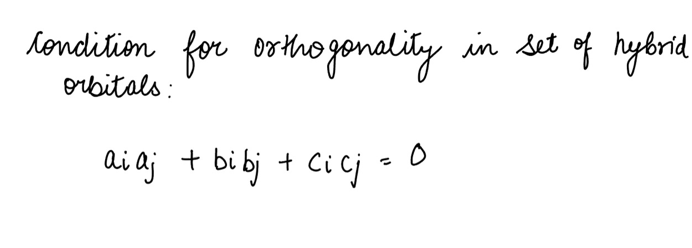Bonding in the BH3 molecule is covalent and can be described by sp2 hybrid orbitals of the form Show that two hybrid orbitals φa andφb are orthogonal.
Bonding in the BH3 molecule is covalent and can be described by sp2 hybrid orbitals of the form Show that two hybrid orbitals φa andφb are orthogonal.
Chemistry
10th Edition
ISBN:9781305957404
Author:Steven S. Zumdahl, Susan A. Zumdahl, Donald J. DeCoste
Publisher:Steven S. Zumdahl, Susan A. Zumdahl, Donald J. DeCoste
Chapter1: Chemical Foundations
Section: Chapter Questions
Problem 1RQ: Define and explain the differences between the following terms. a. law and theory b. theory and...
Related questions
Question
Bonding in the BH3 molecule is covalent and can be described by sp2 hybrid orbitals of
the form
Show that two hybrid orbitals φa andφb are orthogonal.
![### Molecular Orbital Expressions
#### Orbital \( \phi_a \)
\[
\phi_a = \sqrt{\frac{1}{3}} (2s) + \sqrt{\frac{2}{3}} (2p_x)
\]
#### Orbital \( \phi_b \)
\[
\phi_b = \sqrt{\frac{1}{3}} (2s) - \sqrt{\frac{1}{6}} (2p_x) + \sqrt{\frac{1}{2}} (2p_y)
\]
#### Orbital \( \phi_c \)
\[
\phi_c = ?
\]
These expressions represent molecular orbitals, which are combinations of atomic orbitals used to describe the wave-like behavior of electrons in a molecule. The coefficients (such as \(\sqrt{\frac{1}{3}}\), \(\sqrt{\frac{2}{3}}\), etc.) reflect the contribution of each atomic orbital (e.g., \(2s\), \(2p_x\), \(2p_y\)) to the molecular orbital. In the expressions, the \(2s\) and \(2p_x\), \(2p_y\) are atomic orbitals from an atom, likely involved in bonding.
Understanding these molecular orbitals helps in explaining the geometry, bonding properties, and other characteristics of molecules. The question mark under \(\phi_c\) suggests exploring or deriving this particular orbital expression further.](/v2/_next/image?url=https%3A%2F%2Fcontent.bartleby.com%2Fqna-images%2Fquestion%2Fc5a50dc1-17fe-4f06-9b54-35228343592d%2F45ca2a0b-09b3-4dac-beb2-2a9eba4f3a25%2Fh4konq9_processed.png&w=3840&q=75)
Transcribed Image Text:### Molecular Orbital Expressions
#### Orbital \( \phi_a \)
\[
\phi_a = \sqrt{\frac{1}{3}} (2s) + \sqrt{\frac{2}{3}} (2p_x)
\]
#### Orbital \( \phi_b \)
\[
\phi_b = \sqrt{\frac{1}{3}} (2s) - \sqrt{\frac{1}{6}} (2p_x) + \sqrt{\frac{1}{2}} (2p_y)
\]
#### Orbital \( \phi_c \)
\[
\phi_c = ?
\]
These expressions represent molecular orbitals, which are combinations of atomic orbitals used to describe the wave-like behavior of electrons in a molecule. The coefficients (such as \(\sqrt{\frac{1}{3}}\), \(\sqrt{\frac{2}{3}}\), etc.) reflect the contribution of each atomic orbital (e.g., \(2s\), \(2p_x\), \(2p_y\)) to the molecular orbital. In the expressions, the \(2s\) and \(2p_x\), \(2p_y\) are atomic orbitals from an atom, likely involved in bonding.
Understanding these molecular orbitals helps in explaining the geometry, bonding properties, and other characteristics of molecules. The question mark under \(\phi_c\) suggests exploring or deriving this particular orbital expression further.
Expert Solution
Step 1

Step by step
Solved in 3 steps with 3 images

Knowledge Booster
Learn more about
Need a deep-dive on the concept behind this application? Look no further. Learn more about this topic, chemistry and related others by exploring similar questions and additional content below.Recommended textbooks for you

Chemistry
Chemistry
ISBN:
9781305957404
Author:
Steven S. Zumdahl, Susan A. Zumdahl, Donald J. DeCoste
Publisher:
Cengage Learning

Chemistry
Chemistry
ISBN:
9781259911156
Author:
Raymond Chang Dr., Jason Overby Professor
Publisher:
McGraw-Hill Education

Principles of Instrumental Analysis
Chemistry
ISBN:
9781305577213
Author:
Douglas A. Skoog, F. James Holler, Stanley R. Crouch
Publisher:
Cengage Learning

Chemistry
Chemistry
ISBN:
9781305957404
Author:
Steven S. Zumdahl, Susan A. Zumdahl, Donald J. DeCoste
Publisher:
Cengage Learning

Chemistry
Chemistry
ISBN:
9781259911156
Author:
Raymond Chang Dr., Jason Overby Professor
Publisher:
McGraw-Hill Education

Principles of Instrumental Analysis
Chemistry
ISBN:
9781305577213
Author:
Douglas A. Skoog, F. James Holler, Stanley R. Crouch
Publisher:
Cengage Learning

Organic Chemistry
Chemistry
ISBN:
9780078021558
Author:
Janice Gorzynski Smith Dr.
Publisher:
McGraw-Hill Education

Chemistry: Principles and Reactions
Chemistry
ISBN:
9781305079373
Author:
William L. Masterton, Cecile N. Hurley
Publisher:
Cengage Learning

Elementary Principles of Chemical Processes, Bind…
Chemistry
ISBN:
9781118431221
Author:
Richard M. Felder, Ronald W. Rousseau, Lisa G. Bullard
Publisher:
WILEY